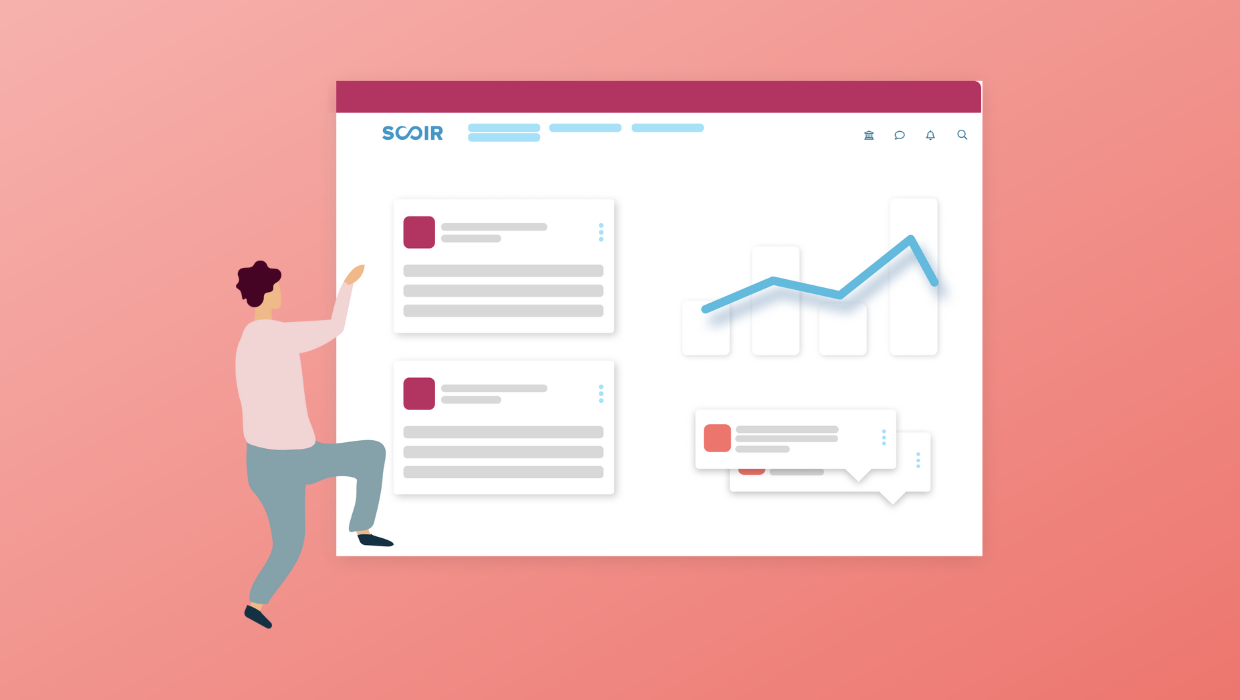4 min read
ACT and SAT Must-Knows for High Schoolers
We recently published a podcast episode on this topic. This blog post provides a recap of what we covered during the episode. Hi! It’s Abby from...
Free for students & their families
Seamlessly integrated, affordable systems for use across your district.
Career Readiness for 6-8 grade, built to guide and track progress in the early years of career exploration.
Scoir + Common App are integrated for the 2025-26 academic year!
Check out content and practical guides to help inform your enrollment strategies and programs.
6 min read
 Mindy Rose
:
November 15, 2024
Mindy Rose
:
November 15, 2024

When I started college admissions counseling 20 years ago, students would come to meetings hefting heavy boxes of viewbooks they'd received from colleges. They'd dump them unceremoniously on my office floor and ask, "How do I tell these schools apart when they all look and sound alike?" As I moved through my career, I began to see fewer viewbooks and hear more complaints about the volume of recruiting emails flooding student inboxes. They, too, looked and sounded the same. Students described feeling lost amid choices and information–not to mention opinions!
Over time, I learned to help students calm their minds by teaching them how to apply the research and decision-making skills central to high school to their college process. As they realize they have everything they need to take on a complex process, students become more motivated to engage deeply in developing an original college plan driven by their values, preferences, and situations. What a joyful sight to see—a once-overwhelmed teenager evolves into a focused young adult equipped with skills that will serve them well beyond college.
 Colleges can contribute to this transformational process by keeping recruitment communications relatable, accessible, and student-centered. Each touchpoint is an opportunity to build or dissolve affinity. But how, when colleges face their institutional pressures to achieve specific results, can they help but deluge students? Most enrollment marketing staff know about the demographic cliff; there are fewer 17-year-olds now than a decade ago, and with that comes incredible pressure to get in front of those planning for college.
Colleges can contribute to this transformational process by keeping recruitment communications relatable, accessible, and student-centered. Each touchpoint is an opportunity to build or dissolve affinity. But how, when colleges face their institutional pressures to achieve specific results, can they help but deluge students? Most enrollment marketing staff know about the demographic cliff; there are fewer 17-year-olds now than a decade ago, and with that comes incredible pressure to get in front of those planning for college.
The first step is acknowledging that recruiting methods of the last decade, once the gold standard, don't work anymore. This generation of students is highly mindful of protecting their Personally Identifiable Information (PII), and they are less engaged with email. To effectively connect with them, college admissions marketing professionals must adopt innovative, targeted, and authentic enrollment marketing strategies that resonate with prospective students.
Check out the top six enrollment marketing trends I’ve observed below.
What was once a tried-and-true solution to engaging students–the digital drip campaign–has encountered serious hurdles, including privacy regulations and bot interference that mean emails may never reach their intended recipient. Still, I know from the experience of my own high school senior and his friends that student inboxes are overflowing and underread. Since today's college-bound students have largely moved away from email as their primary communication tool, colleges must adopt a student-centered methodology that meets students where they are.
By engaging students through SMS and platforms like Discord, I've seen colleges foster communities around (often very specific!) shared interests, providing opportunities for students to develop an organic affinity with an institution. Social media platforms like TikTok and Instagram also provide a vibrant native space for students to connect with campus life in a way that does not feel excessively curated. In my last role in college admissions, I loved seeing the openness and curiosity students showed when connecting with the community in a way that felt natural to them. That brought me to Scoir–as a career student-centered educator, I am excited about a tool that streamlines college-to-student contact. At the same time, as an ethical practitioner, I respect that Scoir doesn’t trade in student data. Instead, it creates a dedicated space for meaningful connections, allowing students to navigate their college search confidently and securely.
Another characteristic of today's college-bound students is their staunch expectation of diverse representation. Students are discerning in evaluating who and what colleges choose to showcase, drawing conclusions about institutional priorities based on content. The most successful outreach reflects the complexity of student populations in a way that feels authentic to the college and relatable to the student. Colleges must represent wide-ranging backgrounds and showcase initiatives, faculty, and staff that support underrepresented groups.
Data analytics can help colleges further personalize their outreach based on students' interests and backgrounds. Leveraging data analytics is powerful enough to allow institutions to prioritize segmented communications to the kind of students they hope to enroll. For instance, if a student is passionate about environmental science, fencing, and student government, tailored communications can highlight aligned programs and campus activities. Or, if an institution is interested in enrolling more students from a specific geographic area, it can tailor communications to those candidates. Students generally respond well to seeing how peers from their home or with their interests now thrive at a particular college. This thoughtful approach makes students feel valued and helps them envision a future where they belong. Once that happens, overstimulation begins to quiet, and focus tightens.
At this moment in internet history, on-demand and recorded video content is an expectation, not a choice. Some colleges are doing excellent work creating clever visual bites to engage students and, at best, share the essence of campus life. Original video content allows colleges to showcase their unique culture, traditions, academic programs, and student experiences in a relatable format. Colleges are also finding success by adopting a college counselor-like approach to outsourcing information, developing webinars and learning series focused on how to apply, prepare essays, and complete financial aid requirements.
I've also seen institutions use platforms like Instagram or TikTok for student takeovers, offering real-life glimpses into daily activities on campus. Live-streamed recorded events—such as virtual campus tours or Q&A sessions—allow prospective students to interact with current students and faculty in a way static content can't achieve. At the same time, recording these events for asynchronous consumption minimizes access and timing issues that have long plagued college recruitment efforts.
Anyone who knows teenagers has experienced how much they value social proof. They look for reviews, testimonials, and success stories of people they admire to help guide their choices. One of my professional breakthroughs was coming to terms with the idea that, as much as I could empower my students by teaching them to act in their best self-interest through rigorous research and revelation, they would continue to seek the input of others whose opinions carried weight.
Colleges can build trust and community by featuring testimonials from current students and alumni, whether on social media or other promotional materials. When prospective students see themselves represented in these stories, they feel a stronger connection to the institution and begin acting as valuable ambassadors.
Since most students rely on their phones for just about everything, it is essential to ensure websites and digital content are mobile-friendly. I have been particularly impressed by how Scoir has met this expectation by creating a network on which students, caregivers, and colleges have a mutual space. Students get into the habit of using Scoir to facilitate the mechanics of their college application process, for example, chipping away at tasks from their phones when convenient. From this same space, through messaging, they also develop meaningful relationships with colleges, including some that otherwise might not have captured their attention.
Students can quickly dismiss college websites as akin to viewbooks, overly similar, and difficult to navigate. By optimizing websites, emails, and applications for mobile viewing, colleges can make significant strides in overcoming this barrier. Institutions with thoughtfully planned and relevant SMS campaigns get students' attention by providing timely updates that help the applicant feel like the college is in their corner. Texting is a productive way to keep students informed and engaged without adding to the clutter, but only when done in moderation and with a helpful tone.
Artificial intelligence is reshaping how colleges engage with prospective students. Embedded website chatbots deliver instant answers to common questions, making it easier for students to find the information they need. The vendor space is full of companies trying to pioneer ways to connect with students, many born during COVID-19 (most sell student PII, and operate as an app in isolation). Colleges moved quickly to embed virtual experiences, like campus tours, to provide a sense of campus life from any location. This content holds great potential to help students feel connected to the campus, even from a distance, supporting colleges' goals to remain accessible and welcoming to all. Up next will be augmented reality experiences to further customize how a prospective student engages with a college community.
One of my favorite reminders to students applying to college is: you can do it! The process was, after all, designed to be completed by seventeen-year-olds. The truth is, over the years, I have seen how the college application process has outgrown itself. Scoir is rightsizing what it means to discover, research, and apply to college by creating a dedicated space for students to explore options, and for colleges to find aligned students. It’s magical to see how both find possibilities that otherwise may have gone unnoticed.
It was so much fun, as a college counselor, to be part of Scoir's early launch into high schools. We marveled at the transformative potential of this intuitive tool–it felt like a revolution! Now, I am turning my attention to helping colleges understand the recruitment power of Scoir. With more than a million users (one out of every seven high school graduates!) on the network, I don't know of another product that can help with the essential questions of college admissions: can I get in, will I fit in, and can I afford it?
Let’s connect to discuss how Scoir can support your institution in reaching the right prospective students. The work means so much more when we recenter on why we are here: to help each student find a place where they’ll grow, learn, and thrive.

Drawing on her 20+ years of experience in college admissions and counseling, Mindy Rose consults with colleges on the unique value of Scoir as a tool to identify, engage, and enroll best-fit students.

4 min read
We recently published a podcast episode on this topic. This blog post provides a recap of what we covered during the episode. Hi! It’s Abby from...

6 min read
Gaining admission to the college(s) of your choice might weigh heavily on your mind at the moment. The odds are that the prospect of affording...

8 min read
The Free Application for Federal Student Aid (FAFSA), managed by the Department of Education, is the gateway to federal and state financial aid for...